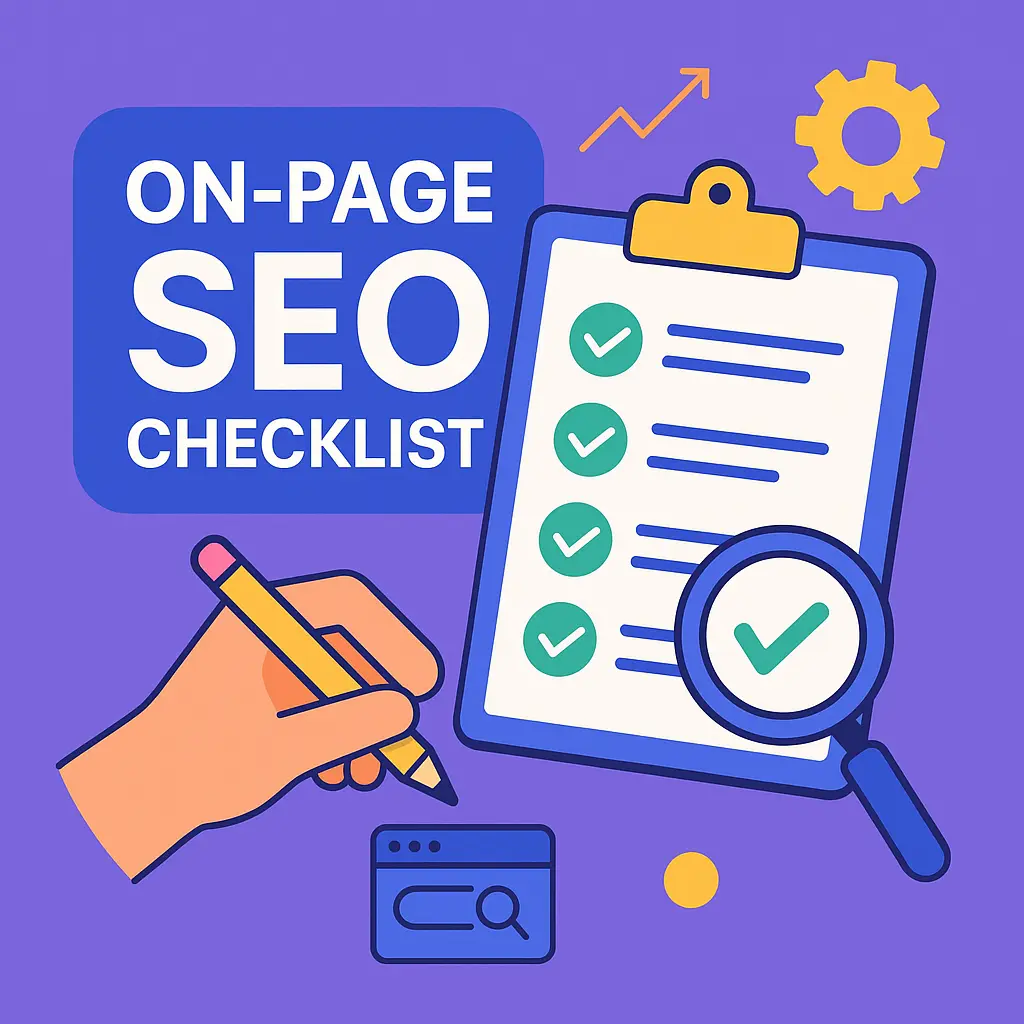What is On-Page SEO?
On-page SEO is the process of optimizing your website’s content, title, description, headings, images, and other elements that can be optimized on the page to make them search engine-friendly, thereby improving both search rankings and user experience.
It includes things like:
- Writing a good title and meta description
- Using key terms in your writing effectively
- Page organization with headings
- Internal links
- Image optimisation and page speed
Briefly, On-Page SEO is the process of informing Google and web users about the content of your page.
Instant Comparison
- On-Page SEO = working within your site
- Off-Page SEO = occurs outside your website (backlinks, mentions, social media presence)
- Technical SEO = how well and fast your site can read by Google (speed, crawlability)
✅The Ultimate On-Page SEO Checklist
This is your checklist to follow step by step for every page or blog post:
1. Optimize Your Title Tags
- Keep title within 50–60 characters
- Put your main keyword early
- Use action verbs or numbers to drive clicks
💡 Example:
❌ Don’t use “On-Page SEO”
✅ Use “On-Page SEO Checklist: 12 Steps to Higher Rankings”
2. Make Useful Meta Descriptions
- Length: 150–160 characters
- Insert your main keyword organically
- Write persuasively so people want to click
💡 Example Meta:
“Get the ultimate on-page SEO checklist. Learn successful strategies to enhance your content and grow Google rankings.”
➡️ Even though meta descriptions are not direct ranking signals, they boost CTR (click-through rate), which indirectly helps SEO.
3. Apply Headers in Order Appropriately (H1, H2, H3)
- One H1 tag (your page title)
- Use H2s for top-level headings and H3s for subheadings
- Naturally add keywords in headings
This makes content scannable for users and understandable for Google.
4. Define URLs Properly
- Keep them short, relevant, and descriptive
- Avoid random numbers or symbols
- Use hyphens (-), not underscores (_)
💡 Example:
❌ yoursite.com/article?id=12345
✅ yoursite.com/on-page-seo-checklist
5. Keyword Placement & Density
Place your primary keyword in:
- Title tag
- URL
- First 100 words
- At least one H2
Also:
- Use synonyms and keyword variations (LSI keywords)
- Write naturally for readers, not robots
6. Optimize Images
- Rename files descriptively: on-page-seo.jpg instead of img123.jpg
- Add alt text describing the image
- Compress images to reduce load time
💡 Pro Tip: Use free tools like TinyPNG or Squoosh to compress images without losing quality.
7. Internal Linking
- Add 2–3 relevant internal links per post
- Use descriptive anchor text (not “click here”)
💡 Example: “Begin with keyword research before on-page SEO application.”
➡️ Internal links improve site navigation, spread link equity, and keep users longer.
8. External Linking
- Link to credible sources if relevant (Google, Moz, HubSpot, etc.)
- Adds credibility and shows your content is well-researched
- Use 1–3 high-quality links only
9. Content Quality & E-E-A-T
Google rewards content that shows:
- Experience
- Expertise
- Authoritativeness
- Trustworthiness
How to apply:
- Add case studies, examples, or personal experience
- Support with data, stats, or references
- Write in clear, plain language
- Keep content updated regularly
💡 Example: Instead of saying “fast websites rank higher”, share your experience improving site speed and its ranking impact.
10. Ensure Your Website is Mobile-Friendly
- Over 60% of searches are mobile
- Test with Google Mobile-Friendly Test
- Ensure fonts, buttons, and images adapt properly
11. Maximize Page Speed
- Check speed with Google PageSpeed Insights
- Enable browser caching & use a CDN
- Compress images and remove unnecessary scripts
➡️ Slow websites frustrate users, increase bounce rate, and harm rankings.
12. Add Schema Markup (Bonus)
- Helps Google understand your content for rich results
- Use free tools like Google Structured Data Markup Helper
- Popular schema: FAQ, HowTo, Ratings
⚡ Rapid On-Page SEO Checklist (Quick Reference)
- ✅ Title tags optimized with keywords
- ✅ Meta description is compelling
- ✅ Proper use of H1, H2, H3
- ✅ Short, keyword-rich URL
- ✅ Keyword in first 100 words
- ✅ Optimized images with alt text
- ✅ 2–3 internal links added
- ✅ Links to authority sites
- ✅ Content shows E-E-A-T
- ✅ Mobile responsive
- ✅ Page speed optimized
- ✅ Schema markup applied
❌ Common On-Page SEO Mistakes to Avoid
- Keyword stuffing (unnatural use of keywords)
- Duplicate meta tags across pages
- Images without alt attributes
- Ignoring internal linking
- Writing content with no real user value
Conclusion
On-page SEO is crucial for achieving higher rankings on Google. By working through this checklist, you make your site more user-friendly, easier for Google to understand, and more authoritative in your niche. Our SEO experts in india can help a website with their on page seo by creating strategies that can help websites rank by on-page seo.
👉 Remember: SEO is not about tricks—it’s about delivering the best experience to users.

